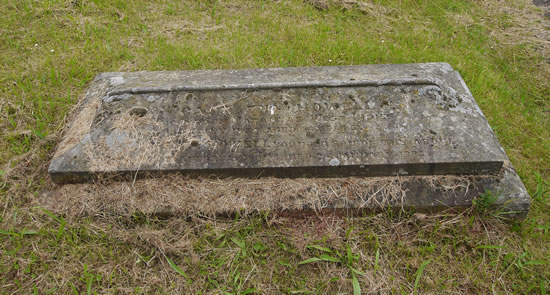St Woolos Cemetery - The Haunted Holy Ground
From the book "The Haunted Holy Ground" by Mike Buckingham and Richard Frame published in 1988.
Pilots, Powder And Prosecutions
By Mike Buckingham and Richard Frame
First published 1988
© Mike Buckingham and Richard Frame 2012
The grave marker which bears the name Thomas Howell is likely to mislead the modern visitor to St Woolos since the man it commemorates is buried four thousand miles away on a Caribbean isle.

The grave of Thomas Howell.
And yet there is a real story there, and it is a story of a young skipper who in 1839, the year of the Chartist insurrection in Newport, set out from Cork with a cargo itemised thus: 600 barrels of gunpowder, 80 bales of bacon, 20 firkins of butter, 310 sacks of oats and assorted other stores.
It was a fair wind all the way from Cork and no sooner had the crew settled down to the voyage than they were picking up the Channel pilot ready for docking at Newport where a magazine not far from where the current George Street bridge now spans the Usk was ready to receive the gunpowder.
What followed was a classic, set-piece of bureacracy and one which must have helped drive skipper Thomas to his lamentably early grave, for he was only 46 when he succumbed to yellow fever on an alien shore and died.
For some reason which even now we do not know the harbourmaster, Captain Watkin Richards, invoked an Act of Parliament which laid down that no dealer in gunpowder should keep more than 200 pounds weight of explosives within a mile of a settled community. Bear in mind that these were politically troubled days and the government was extremely anxious that shot and powder should not fall into the hands of insurrectionists.
Immediately there was a protest from the young skipper who had literally sailed into trouble. Howell told the port authorities that he had been directed to his moorings by a pilot, Mr Cox, who was well aware of the regulations relating to the importing of gunpowder.
The subsequent court hearing was one at which all the evidence seemed to go against the Crown and yet the authorities got their way.
Whichever side of the argument they took, readers of the Monmouthshire Merlin at the time were treated to an unparalleled display of hairsplitting and reading through the evidence today it is quite clear that even if Howell’s ship Active was within the prohibited zone it could only have been a matter of feet. And yet with a persistence which Governments sometimes show even when the most minor infringements are made the prosecution went ahead with bewigged counsel appearing for either side.
A Mr Wade, a land surveyor, produced a map showing the nearest point of the then Newport boundary and the spot where the Active with its explosive cargo was proved to have lain. The diligent expert testified that he had measured the distance from one point to the other and had found the boat to have been moored several yards within the prohibited area.
As it happened this was extremely embarrassing for the town of Newport and the prosecution, since if the Active was moored downriver of the powder magazine and was inside the prohibited area, it also meant the magazine itself was illegally situated.
Thomas Howell was not the first and certainly not been the last to find out that it is rarely worthwhile to argue the toss with authority.
Strong - indeed almost irrefutable - as his case was he lost and was fined a very large amount.
But the Howells are a doughty people, and a modern descendant, Cedric Howell, a great grandson and part of the family which went on to become prominent in the life of the town as steel stockholders still stoutly defends his viewpoint that Thomas was in the right as indeed he appears to have been.
An interesting point is that Mr Woollet, referred to earlier as active in the Roman Catholic cause on the burial board at St Woolos was the young Mr Howell’s defence counsel.
But why was such a prosecution undertaken at all? Perhaps rumours going around at the time provided us with a clue.
It was said at the time that the very considerable fine extracted from Mr Howell and his shipping company was divided equally between the borough of Newport and the harbourmaster. It was an ill wind which blew Howell into Newport that day in 1839. But perhaps the party really in the wrong was found out after all, for not long after the trial the old gunpowder magazine was knocked down and rebuilt further down river, where its distance from the centre of Newport was beyond doubt.
It is an injustice that still rankles with Mr Cedric Howell. “Even after 150 years have passed I should still like to see the record put straight,” says Cedric.
Although Cedric’s forebear rests far from home St Woolos is the burial place for large numbers of the rest of his family, including his brother who died during World War Two while serving with the Royal Air Force.
On the maternal side of Cedric’s family is the Mordeys, and the founder of Mordey and Carney ship repairers and builders Mr Mark Mordey is also buried there.
Which brings us on to a little mystery to finish off this tale. Without anybody knowing who is responsible Mr Mark Mordey’s grave has been restored, with its lettering picked out afresh and the railings cleaned and painted. Les says he doesn’t know who has carried out the work neither does the cemetery’s superintendent.